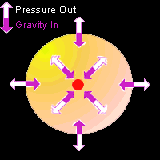Try It
Now that you have explored a process for determining the meaning of general academic and domain-specific vocabulary, you will practice your new learning by reading the following text about the birth, life and death of a star. As you read and uncover the meaning of unfamiliar words in the text, remember to ask yourself:
- What is the text about? What is the central idea?
- What context clues surround the highlighted words?
- Are there any synonyms or antonyms for the highlighted word?
- Are there any prefixes or suffixes that you recognize? How can these prefixes or suffixes help you determine the meaning of the unknown words?
- How does the visual information help you determine the meaning of unknown words?
You will be examining major sections in the text in order to use the strategies that you have learned to determine the meaning of domain-specific vocabulary. Read paragraphs 1 and 2 from the NASA article “Stellar Evolution - The Birth, Life, and Death of a Star”opens in new window, and then complete the follow-up activities.
Stellar Evolution - The Birth, Life, and Death of a Star
1 The Milky Way Galaxy contains several hundred billion stars of all ages, sizes and masses. A typical star, such as the Sun, radiates small amounts of X-rays continuously and larger bursts of X-rays during a solar flare.
2 The Sun and other stars shine as a result of nuclear reactions deep in their interiors. These reactions change light elements into heavier ones and release energy in the process. The outflow of energy from the central regions of the star provides the pressure necessary to keep the star from collapsing under its own weight.

Pressure out = Gravity in
– NASAopens in new window, September 4, 2003








